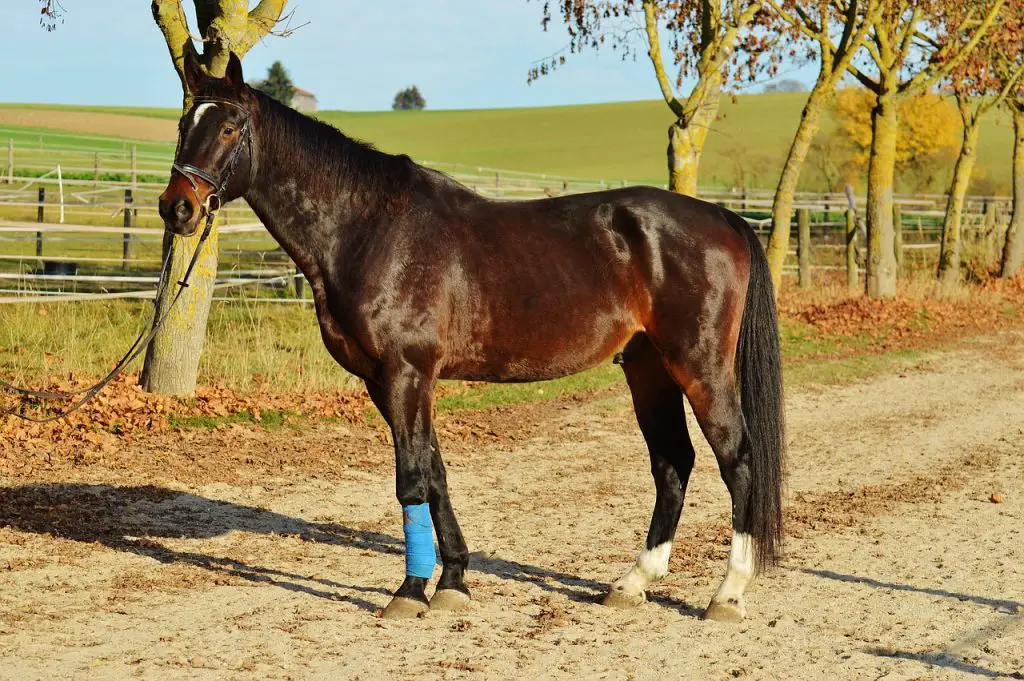Last Updated on March 24, 2022 by Allison Price
People often refer to horses as “bowed” when they say that they have a “bowed tendon”. This is usually due to the tearing and rupturing of the superficial digital flexible tendon located in the middle cannon bone. The result is a bow-like, curved swelling at the back of the leg. It occurs between the knees and the ankle. The swelling is most common in the middle cannon bone. However, it could be behind the knee at the level the ankle or extend to the pastern.
Many people believe tendon injuries like “bowed tendons”, which can occur in racehorses, are only a problem. Tendon injuries can happen to any horse of any breed, and any type, regardless of their activity. Tendon injuries are more severe than other types of fractures. This is because tendon healing takes a long time and replaces the torn tendon fibers by fibrous scar tissue. The tendon after healing is complete is less elastic and more susceptible to re-injury.

A persistently weak tendon may prevent a horse from returning to the same level of performance after sustaining a serious injury. The superficial digital tendon is composed of longitudinally arranged protein fibers. It forms a long attachment between the muscle above and the short pastern bones above the hoof. Although tendon fibers can be stretched and loaded beyond their limits, they are elastic. The tendon fibers can be damaged by improper positioning of the leg relative to the horse’s weight. This can happen when the horse is tired or changes its gait after crossing a fence. Tendon damage can also be caused by unbalanced loading, improper shoeing, poor conformation, or uneven footing. Sometimes this overload is caused by a single mistake, while in other cases it may be due to cumulative stress or fatigue.
The tendon fibers can tear and cause bleeding. This causes pain, swelling, heat, or acute swelling. Horses may experience lameness or not. Many horses who have suffered severe tendon injuries are not lame. Edema (fluid accumulation) can cause swelling around the tendon. The local swelling and inflammation can be reduced by applying ice or cold compresses to the affected area and then bandaging the leg. The horse should be kept in its stall and only allowed to walk. Talk to your veterinarian if the horse is experiencing severe pain or swelling.
Because palpation of the legs is not reliable in determining whether there are tendon injuries, consult a veterinarian to arrange for an ultrasonographic evaluation. Ultrasonography can be used to assess the integrity of tendon fibers and other important parameters such as the cross-sectional area, alignment, and echogenicity. Density is a key factor in the tendon’s echogenicity. Normal tendon is bright white, echogenic. An abnormal tendon can appear various shades of gray (hypoechoic), or black (anechoic). A veterinarian will be able to confirm tendon damage by using ultrasonographic findings. To ensure that the tendon is at its best, the ultrasound exam should be scheduled between five and seven days after the injury.
A slight tendon injury may cause a decrease in tendon cross-sectional area, but no actual fiber tearing. Total tendon rupture may result in complete tendon destruction, loss of tendon fibers and a significant increase in tendon cross sectional area. The majority of tendon injuries are somewhere in the middle. There is a small area of fiber tearing on the ultrasound image (black hole or dark gray hole) and an increase in the tendon cross-sectional size. The ultrasound image shows a hole where tendon fibers are torn. This is caused by blood and granulation tissue.
A veterinarian can help you develop a rehabilitation program for your horse if it has sustained a tendon injury. Horses need to be kept in stalls for two months, with limited exercise. This can vary depending on the severity of the injury and the horse’s temperament. A controlled exercise program and confinement will help to heal the tendon. The horse should be only walked by the owner at first. Cold hosing will not be necessary or beneficial once the tendon has cooled. The tendon may remain thickened and will continue to swell if DMSO is applied topically.
To determine if the tendon is healing enough to allow for increased exercise, a veterinarian will need to perform an ultrasound on the horse’s leg about every 60 days. A gradual increase in exercise could mean jogging for five minutes or turning out in a small area. The amount of exercise you do will increase gradually over time, depending on how your follow-up ultrasound exams go. Tendon rehabilitation can take a long time and can prove frustrating for horses that have suffered re-injury. These setbacks can be eliminated by regular ultrasounds that monitor the horse’s progress.
Recent research in veterinary medicine focuses on how to improve the outcome tendon injuries using regenerative medicine. In order to improve tendon repair quality, plasma products or stem cells from horses are being used more frequently. Tendon injections can also be combined with surgical treatments such as tendon splitting or superior check ligament desmotomy. Tendon healing can also be promoted by other treatment options such as low-power lasers, therapeutic ultrasound, hydrotherapy, electromagnets, and acupuncture. Your veterinarian will help you choose the right treatment for your horse. Even though tendon injuries can be very serious, most horses can heal and resume their athletic performance if they are given the right time. Even if the tendon is severed, it’s likely that horses will be able return to less strenuous activities. A veterinarian should be able to quickly diagnose and treat the tendon.


